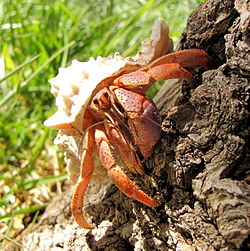Description
The name Anomura derives from an old classification in which reptant decapods were divided into Macrura (long-tailed), Brachyura (short-tailed) and Anomura (differently-tailed). The alternative name Anomala reflects the unusual variety of forms in this group; whereas all crabs share some obvious similarities, the various groups of anomurans are quite dissimilar. [3]
The group has been moulded by several instances of carcinisation – the development of a crab-like body form. [4] Thus, the king crabs (Lithodidae), porcelain crabs (Porcellanidae) and hairy stone crab (Lomisidae) are all separate instances of carcinisation. [4]
As decapods (meaning ten-legged), anomurans have ten pereiopods, but the last pair of these is reduced in size, and often hidden inside the gill chamber (under the carapace) to be used for cleaning the gills. [5] [3] Since this arrangement is very rare in true crabs (for example, the small family Hexapodidae), [6] a "crab" with only eight visible pereiopods is generally an anomuran. [3]
This page is based on this
Wikipedia article Text is available under the
CC BY-SA 4.0 license; additional terms may apply.
Images, videos and audio are available under their respective licenses.







